
Bringing ocean-bred nutrition to America’s dinner table
BY AIYANA HAVIR
Remember those green, slimy shrubs that tangled your ankles in the ocean as a kid? Seaweed is more than just a beach trap or sushi wrap; it answers an important nutritional void of fiber, vitamins, minerals and vegetable iodine in the western diet.
Algae originated about three and a half billion years ago and have been used extensively by a variety of cultures for food, healing medicines, ceremonies and fertilizer. Sea vegetables, also known as seaweed, is a marine macro algae that hasn’t quite made it to America’s taste buds mainly because it’s been misconceived as a stringy plant instead of essential nourishment.
Sea vegetables are up to 60 times more nutritionally dense than land plants. Spinach, for example, is 85 percent non-digestible fiber. Seaweed, on the other hand, is rootless and can be consumed solely for the health benefits with only 15 percent fiber.
Growing nearly two feet a day and up to 100 meters tall, seaweed is a harvest-worthy sustainable crop that regrows so quickly it leaves the ecological process undisturbed.
Sea vegetation symbolizes the beginning of the food chain. Humans cannot consume the energy from sunlight or nutritious seawater, but seaweed can through the process of photosynthesis. The ocean’s nutritional benefits can thus be reaped because of seaweed’s conversion from inorganic matter to organic substances.
“It’s greatly powerful because it [has] so many nutrients in organic form,” said seaweed farmer and founder of FarmaSea® Health LLC, Scott Kennedy. Kennedy began studying sea vegetables in 1983 to carry on the research work of the Wachter family that began in the 1930s.
Japan’s island culture illustrates the impact of sea vegetation. They incorporate on average about seven grams of macro-algae seaweed daily into their diets. As a result, they have the highest longevity rate and a low percentage of diet-based diseases, Kennedy said.
Sea vegetables are high in antibiotic, antiviral, and antibacterial properties, as well as a main source of vitamins and minerals.
Raw food and nutritional supplements packed with these vitamins and minerals are a much better alternative than synthetic vitamins, Kennedy said. The majority of Americans do not consume enough fruits and vegetables, and adding sea vegetables to their intake can improve nutritional balance.
So how can these sea veggies become part of daily regime? Easy. While typical recipes like miso soup and sushi suffice, it doesn’t hurt to think outside the box. Seaweed can be used in casseroles, risottos, stews, salads, and vegetable dishes of any kind. If on-the-go meals sound more appealing, try seaweed snacks, pill-form supplements, or drink mixes sold in health food stores.
“A little bit every day makes a lot of difference,” Kennedy said. “It’s the least we can do, but it’s the most we can do.”
Providing a high source of vegetable iodine, seaweed can help achieve ultimate health in three to five years, but benefits can be seen immediately depending on the individual, he said. It can also help prevent diseases ranging from allergies and diabetes to lung cancer and high cholesterol.
“It’s imperative that we look at what we are eating because so many of these degenerative diseases are tied to diet and lifestyle,” Kennedy said.
In a recent article by Dr. Mao Shing Ni, an expert on Dr. Oz’s panel, he explains how seaweed is the miracle vegetable. Nori seaweed, for instance, improves skin health from its omega-3 natural oils blocking toxins. Thyroid hormones and metabolism controllers are also found in Kombu-and the iodine in this seaweed can help those with thyroid deficiencies as well as metabolic boosting for weight management.
“We have to somehow incorporate this into the American diet to change the landscape of health,” Kennedy said.
Recipe

Lemon & Ginger Seaweed Salad
Ingredients:
- 2 cups seaweed
- 1 tablespoon soy sauce
- 1 teaspoon sugar
- 1 tablespoon rice wine vinegar
- 1 tablespoon sesame oil
- 1 teaspoon finely grated, fresh ginger
- 3 teaspoons fresh lemon juice
- 1 clove of, finely minced garlic
- 1 tablespoon toasted sesame seeds
- Add crushed chili peppers for a spicy kick!
Preparation
Rinse the seaweed for 5 minutes in cold water to release the salt. Let it soak for another 10 minutes. Drain the seaweed and pat dry with towels to ensure all moisture is gone. Whisk the lemon juice, vinegar, salt, garlic, ginger, soy sauce, and sesame oil together in a bowl. Toss the dressing with the sesame seeds and seaweed. Enjoy!
SOURCES
http://www.doctoroz.com/blog/mao-shing-ni-lac-dom-phd/seaweed-miracle-vegetable-sea
http://iamafoodblog.com/seaweed-salad-recipe/
http://www.publicradio.org/columns/splendid-table/recipes/side_seaweedsalad.html





